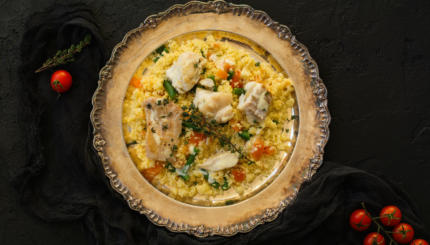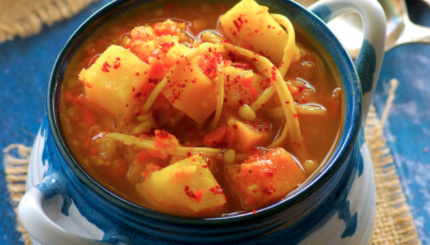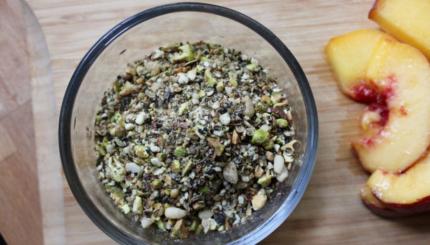This article illustrates a recent trend among American Jews of Eastern European origin: They are embracing the cuisine of their brethren. It is an example of the blurring of traditional cultural lines that takes place among American Jews. Reprinted with permission from the Forward newspaper.
Back in the day, Sabbath meals at Rissi Zweig’s home in New Jersey consisted of gefilte fish, mayonnaise-based salads, kugels, chicken, meat, a couple of cakes and some nondairy ice cream. “And that’s just Friday night,” she said.
Chuck the Cholent
But such artery-clogging decadence is so last decade. Now, “We try to model our home after the Sephardic tradition [which includes those Jews of Spanish and Mediterranean descent],” said Zweig, who prefers a menu of grilled fish, salads, whole grains, and lots of fruits and vegetables.
Ladies and Gentlemen, it’s time to chuck the cholent, lynch the latkes, and ban the brisket: Now is the moment of Sephardic food. In the never-ending search for the “latest” thing, Ashkenazic Jews [those of Eastern European descent] are embracing Sephardic cooking by the multitudes, attending Sephardic cooking courses, buying up cookbooks (Sephardic-influenced cookbooks are the top-selling Jewish cookbooks on Amazon.com), liberally using olive oil (how very Mediterranean), and consuming ubiquitous tubs of hummus, now found everywhere from small-town supermarkets to pizzerias. And while the Sephardic community has been eating this way for thousands of years, only recently are Ashkenazic Jews discovering its spicy, diverse and healthful appeal.

Help us keep Jewish knowledge accessible to millions of people around the world.
Your donation to My Jewish Learning fuels endless journeys of Jewish discovery. With your help, My Jewish Learning can continue to provide nonstop opportunities for learning, connection and growth.
 Of the recipes in his recent book Adventures in Jewish Cooking (Random House), kosher chef Jeffrey Nathan estimated that “80 percent or more are Sephardi–even though I’m Ashkenazi.”
Of the recipes in his recent book Adventures in Jewish Cooking (Random House), kosher chef Jeffrey Nathan estimated that “80 percent or more are Sephardi–even though I’m Ashkenazi.”
“To me, what I’m finding is that people are going away from standard Ashkenazic foods like cholent,” he said. “Sephardicfoods are not only more healthy but also more tasty. They’re making Israeli salads with couscous or Moroccan spiced salmon.”
Nathan has made the switch in his upscale Manhattan kosher restaurant, Abigael’s, as well. “There’s a certain mashed potato that I do,” he said. “I used to use nondairy creamer and margarine–margarine is the worst thing in the world for you. Now I use just a little bit of vegetable broth and olive oil. It tastes better, without a doubt. Instead of rich sauces, I’ve turned to salsas made with fresh fruits and vegetables, cilantro, acids like vinegar, and limes.”
American Jewish tables, Middle Eastern Fare
Today, American Jewish tables are often adorned with Middle Eastern salads such as hummus and babaganoush. “Having pita and hummus is very much a part of my daily fare,” said Carolyn Hessel, executive director of the Jewish Book Council. “To me, it’s Jewish food. But you never would have had it years ago–forget it. Never would have happened.”
According to Pearl, president of Blue and White Foods, which distributes Sabra Salads, “We’ve had a very large growth in the past three years, about 30 percent each year,” he said. “We’re getting into more and more American food chains, not only ethnic stores.”
And while Middle Eastern and Mediterranean food spreads across the country, “the main thrust of our business is the Jewish market,” Pearl said.
A self-described “Yankee doodle dandy,” “I grew up with gefilte fish and kneidlach,” Pearl said. “Many of the foods we bring I never head of as a child–malawach, couscous, borekas.”
During the establishment of the Jewish State, the adoption of Middle Eastern cuisine represented a rejection of Old World culture. In his 1971 book, Israelis: Founders and Sons, Amos Elon notes that as Israelis established a new Jewish culture, they created a new cuisine as well.
Indeed, fans of Sephardic cuisine are often influenced by extended stays in Israel. Upon their return to the United States, they’ve maintained their connection to the Jewish state through their culinary choices. “On kibbutz, for meals you’d flop down, take cucumbers, cut them up and make your own salad,” said Joan Nathan, author of “Jewish Cooking in America,” who considers Sephardic cuisine her “preferred” food. “When I was young, I realized this was the way to eat; everything is fresh. Sephardic food is much more interesting, and healthier.”
Literally, the word “Sephardic”— from the biblical word Sepharad, meaning Spain — refers to the descendants of Jews who were expelled from Spain and Portugal, many of whom settled in Turkey and the Balkans. In common speech, however, the term has expanded to include Jews from throughout the Mediterranean, Middle East, and Asia. As such, Sephardic flavors span Aleppian artichoke salad to Indian aloo makala (deep-fried potatoes) to Italian kosher-for-Passover pan di spagna (sponge cake).
“Part of the allure of Sephardic food is that it’s so diverse compared to the relatively limited range of Ashkenazicfood,” said Matthew Goodman, the Forward’s Food Maven columnist. Goodman is working on a cookbook, Jewish Food: The World at Table (Harper Collins, 2004), which he said is at least 80 percent Sephardic.
“Askenazic food comes from a fairly limited geographic area — one that is not especially blessed in terms of its natural environment,” Goodman said. “Very few vegetables grow there–only roots like cabbages, potatoes, beets, carrots–and very few herbs.”
Roots of Sephardic Jewry in U.S.
As it happens, Sephardic Jews were the first to arrive in the United States, beginning in 1654, when 23 Portuguese Jews arrived on these shores. That same year, the first Jewish congregation in the U.S., Shearith Israel, was established in New York City. Despite two more waves of Sephardic immigration–Jews from the former Ottoman Empire in the early 20th century and Asian and North African Jews following World War II–Ashkenazim soon dominated the American Jewish landscape.
Today, according to Esme Berg, director of Sephardic House, the cultural division of the American Sephardic Foundation, there are an estimated 250,000 Sephardim in the U.S., nearly nine percent of the American Jewish population.
According to Shelomo Alfassa-Marks, a vice president at the Foundation for the Advancement of Sephardic Studies and Culture, awareness of Sephardim is growing in the American Ashkenazic community.
In the Jewish community at large, “I see more and more Sephardic functions,” the Miami resident said. “The Hadassah in Delray Beach, for example, is having a Sephardic luncheon — and they’re all Ashkenazi. There are lots of joint Yiddish-Ladino concerts; there’s three this week in south Florida alone. The Ashkenazim are starting to understand how important our tradition is.”
“Now, we do say, ‘Ashkenazic and Sephardic culture,'” said Hessel. “We recognize that we’re two parts of a whole–very much a whole.”
“Even though the expression, culinarily, is different, it still speaks to the same impulse,” Goodman said. “There are still meals designed for Shabbat, still matzo for Pesach, still no mixing of meat and milk. Even though they might not fry potato latkes on Chanukah, in Greece they make fried dumplings, in Morocco, fried doughnuts. The idea of using the oil is still there — it’s recognizable to us.”
“For me, cooking Sephardic food is going into tradition,” said Joan Nathan, “It’s carrying on all the Jewish traditions — it’s getting the best of Jewish foods.”
Health Conscious American Jews
Many health-conscious American Jews are drawn to Sephardic cooking as part of “the whole Mediterranean diet that everyone’s been pushing,” said Joan Nathan. “Everything is with olive oil; there’s more fruits and vegetables and less meat.”
“Baby-boomers are dressing differently, eating differently,” said Jeffrey Nathan, who said he has lost 34 pounds since putting himself on a Sephardic-inspired diet two months ago. “This is part of the change. We’re saying, ‘Hey, it’s time to eat healthy.'”
As for food at the Zweig home, “I make sure our way of celebrating a holiday is to have things that people like, things that are healthy,” Zweig, a paralegal, said of her switch to Sephardic cuisine. “People are happy, crunching away.”


